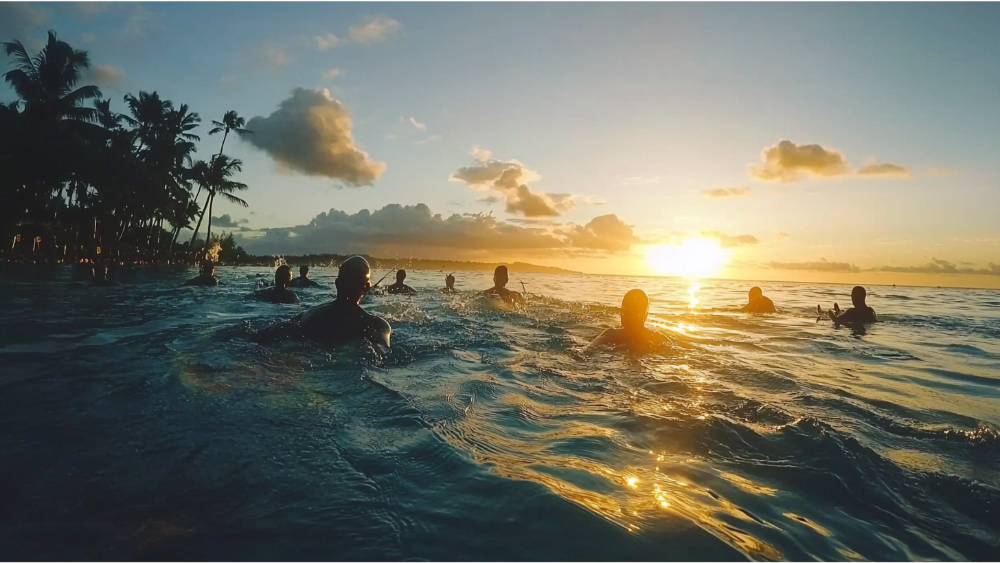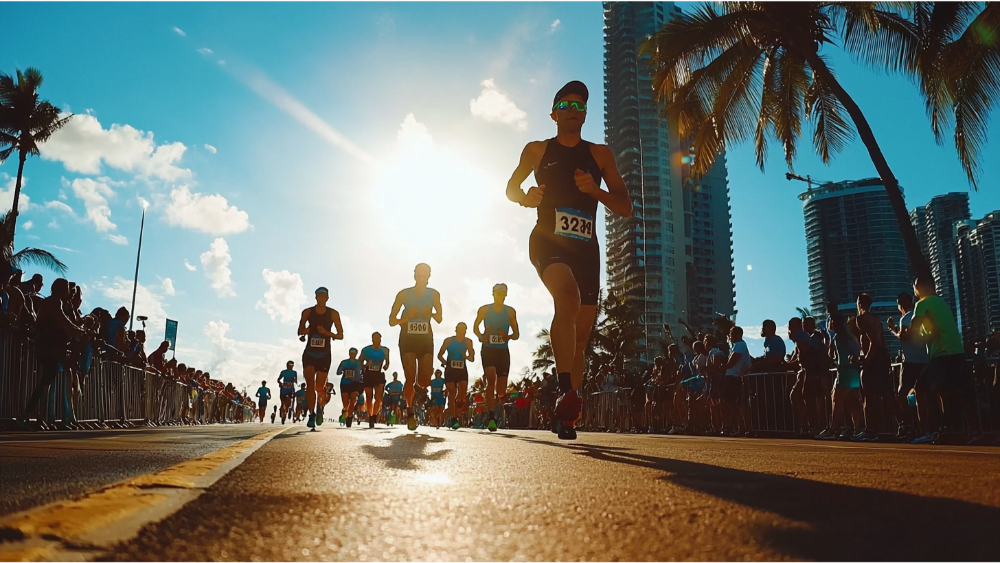An Ironman Triathlon is one of the most challenging endurance events globally, combining swimming, cycling, and running. It began in Hawaii in 1978, designed to determine which sport demanded the most endurance. The total distance is 140.6 miles, composed of:
- Swimming: 2.4 miles (3.86 km)
- Cycling: 112 miles (180.25 km)
- Running: 26.2 miles (42.2 km)
This multi-discipline race requires athletes to excel not only in physical strength but also in mental endurance, strategy, and efficient time management to complete the event within the set cutoff times.
Breakdown of Ironman Race Components
The Ironman Triathlon is a three-discipline race fitted with swimming, cycling, and running. Here is a breakdown of each discipline so you know what to expect when doing an Ironman.
Swimming Distance (2.4 miles/3.86 km)
The swim takes place in open water, testing athletes’ stamina against natural conditions like waves and currents. Proper technique and training in open water are essential to handle the unpredictability of currents, tides, and visibility challenges. Athletes often train in lakes, oceans, or rivers to prepare for different water conditions.
Cycling Distance (112 miles/180.25 km)
This longest segment often includes challenging terrain and elevation. It demands not only physical endurance but also familiarity with various road conditions, including hilly terrains and rough surfaces. Athletes must build cycling stamina through long-distance rides and hill training, while also optimizing their biking posture for aerodynamics.
Running Distance (26.2 miles/42.2 km)
The marathon run is the final segment, pushing competitors to their endurance limits. After completing the swim and bike segments, fatigue sets in, making the marathon a true test of an athlete’s endurance and mental toughness. Training plans typically incorporate long runs and intervals to build the stamina needed for this final stretch.
Transitions and Their Importance
Quick and efficient transitions between swimming, biking, and running save crucial time and energy. Referred to as T1 (swim-to-bike) and T2 (bike-to-run), these transitions are often called the “fourth discipline” in triathlons. Athletes practice these to minimize downtime, practicing techniques like removing wetsuits, securing helmets, and mounting their bikes quickly. Streamlining these processes is vital for reducing overall race time.
Different Types of Ironman and Triathlon Distances

Full Ironman (140.6)
Distance Breakdown:
- Swim: 2.4 miles
- Bike: 112 miles
- Run: 26.2 miles
Average Time and Cutoff Limits
Average completion times range between 12 and 14 hours. The cutoff times include 2 hours 20 minutes for the swim, 10 hours 30 minutes for the bike, and 17 hours for the entire race. This requires strategic pacing to ensure energy is conserved for each segment while staying within these limits.
Half Ironman (70.3)
Distance Breakdown:
- Swim: 1.2 miles (1.9 km)
- Bike: 56 miles (90 km)
- Run: 13.1 miles (21.1 km)
Average Times and Cutoff Limits
The swim cutoff is generally 1 hour, the bike 5 hours, and the overall race must be completed within 8.5 hours. The Half Ironman serves as a stepping stone for athletes progressing toward the full distance, offering an intermediate challenge that requires less training time while still being demanding.
Olympic Distance Triathlon
This intermediate-level distance consists of a 0.93-mile swim, a 24.8-mile bike ride, and a 6.2-mile run, making it a common preparatory event for athletes. Many use this distance to build speed and familiarity with racing strategies, transitions, and pacing before moving on to longer events like the Half or Full Ironman.
Sprint Distance Triathlon
The shortest of the standard triathlon distances, it includes a 0.47-mile swim, a 12.4-mile bike ride, and a 3.1-mile run, suitable for beginners. Athletes new to triathlons often start with Sprint distances to develop their skills and build confidence before tackling longer events.
Preparing for Ironman Distances
Training Essentials for Each Discipline
- Swimming (Open Water Techniques and Training Tips):
Athletes focus on building endurance and practicing open-water techniques such as sighting (keeping an eye on markers to swim straight) and dealing with waves. Training also involves practicing breathing techniques and stroke efficiency to conserve energy over a long distance. - Cycling (Building Endurance and Hill Training):
Long rides and hill training are key to building strength and stamina. Cyclists also work on cadence (pedal speed) and gear-shifting techniques to optimize efficiency on different terrains. Additionally, bike fitting and posture adjustments are crucial for comfort and performance, especially during long rides. - Running (Marathon Prep and Transition Drills):
Incorporating brick workouts—cycling followed by running—helps simulate race-day fatigue and prepares athletes for the transition from biking to running. Long-distance runs and speed intervals are also part of the training regimen to build endurance and running efficiency.
Transition Training: The Fourth Discipline
Efficient transitions, such as removing wetsuits and quickly mounting bikes, are essential for reducing overall race time. Athletes practice these movements repeatedly, optimizing every step to ensure swift, smooth transitions that conserve time and energy.
Nutrition and Hydration Strategies
Nutrition Before, During, and After the Race:
Athletes consume a balanced diet rich in proteins, carbohydrates, and fats to sustain energy. On race day, they often rely on gels, energy bars, and electrolyte drinks to maintain glucose levels and prevent cramping.
Hydration Tips for Long-Distance Events:
Electrolyte-rich drinks are crucial for maintaining hydration during long races. Proper hydration strategies are critical, as dehydration can lead to severe performance issues and even medical emergencies during these demanding events.
Famous Ironman Events Around the World

- Ironman World Championship (Kona, Hawaii):
Known for its harsh conditions, including extreme heat and strong crosswinds, this race attracts the world’s top endurance athletes. It’s considered the pinnacle of Ironman races, where qualifying is an achievement in itself. - Other Popular Ironman Races:
- Ironman California: Known for its scenic yet challenging course, this event attracts a large number of competitors each year.
- Ironman France: Features significant elevation changes, testing cyclists’ hill-climbing abilities and endurance.
- Ironman Lake Placid: A historic race with a supportive community and a stunning course through the Adirondack Mountains.
Challenges and Cutoff Times in Ironman Events
The swim segment has a 2-hour 20-minute cutoff, the bike segment must be completed within 10 hours and 30 minutes, and the full race within 17 hours. These cutoff times push athletes to balance speed with endurance, making pacing strategies critical. Failing to meet one of these cutoff times will disqualify you from the race and you will not be allowed to continue the race further.
Environmental and Course-Specific Challenges
- Weather Conditions and How They Affect Performance:
Events like Kona are known for high temperatures and humidity, which can lead to dehydration and exhaustion. Athletes must adapt their strategies and gear, using cooling techniques and hydration packs. - Elevation and Terrain Variations:
Hilly courses, such as those in Ironman France, test both strength and endurance. Athletes train extensively on hills to prepare for these specific challenges and develop tactics to manage their energy efficiently.
Strategies for Success in Ironman Distances
Training Plans for Different Ironman Distances
Plans vary based on experience, with emphasis on long-distance sessions, speed work, and cross-training for peak performance. Beginners often start with base training, while experienced athletes focus on fine-tuning their skills and speed.
Gear and Equipment Recommendations
- Choosing the Right Bike and Accessories:
Selecting aerodynamic bikes and helmets enhances performance during the cycling leg. Athletes also invest in bike shoes, padded shorts, and hydration systems tailored for long rides. - Wetsuit Options and Swim Gear:
Ensuring proper fit and flexibility in wetsuits improves speed and comfort. Additional gear like swim goggles with anti-fog lenses enhances visibility in open water. - Running Shoes and Apparel Tips:
Lightweight and supportive shoes are critical for enduring the marathon distance. Compression garments are also popular for reducing muscle fatigue during long runs.
Mental Preparation and Race Day Strategies
Techniques such as visualization and maintaining a steady pace help athletes stay focused and avoid burnout. Mindset training is as important as physical training, helping athletes push through the mental and physical challenges of the race.
Frequently Asked Ironman Distances Questions
How long does it take to complete a full Ironman?
On average, completing a full Ironman takes around 12 hours, depending on the athlete’s level of experience and the specific challenges of the course. Elite athletes often finish around the 8-hour mark, while the average age-group participant completes it closer to 14 hours. The official cutoff time for finishing an Ironman is 17 hours, with specific cutoffs for each discipline to ensure athletes maintain a pace to complete the race safely.
What is a good time for a Half-Ironman?
On average, competitive athletes aim to finish a Half-Ironman in about 4 to 6 hours. Elite athletes can often complete the distance in under 4 hours, while seasoned age-group participants might target a time between 5 and 6 hours. For many recreational athletes, a time under 7 hours is considered respectable.
How should I train for my first Ironman?
Training for your first Ironman requires a structured plan that incorporates building endurance, improving swimming, cycling, and running skills, and integrating strength and flexibility workouts. Consistency is key, and working with a coach can be invaluable as they personalize your training plan, provide expert guidance, and help with motivation and accountability. A coach can also assist in fine-tuning pacing strategies, nutrition plans, and mental preparation tailored to your individual needs.
Can I walk during the marathon portion of the Ironman?
Yes, you are allowed to walk during the marathon portion of an Ironman. Many athletes incorporate walking intervals as part of their race strategy to conserve energy and manage fatigue, especially during the later stages of the race. It’s important to maintain a pace that allows you to meet the cutoff times while ensuring you can complete each segment of the marathon comfortably.

Leave a Reply